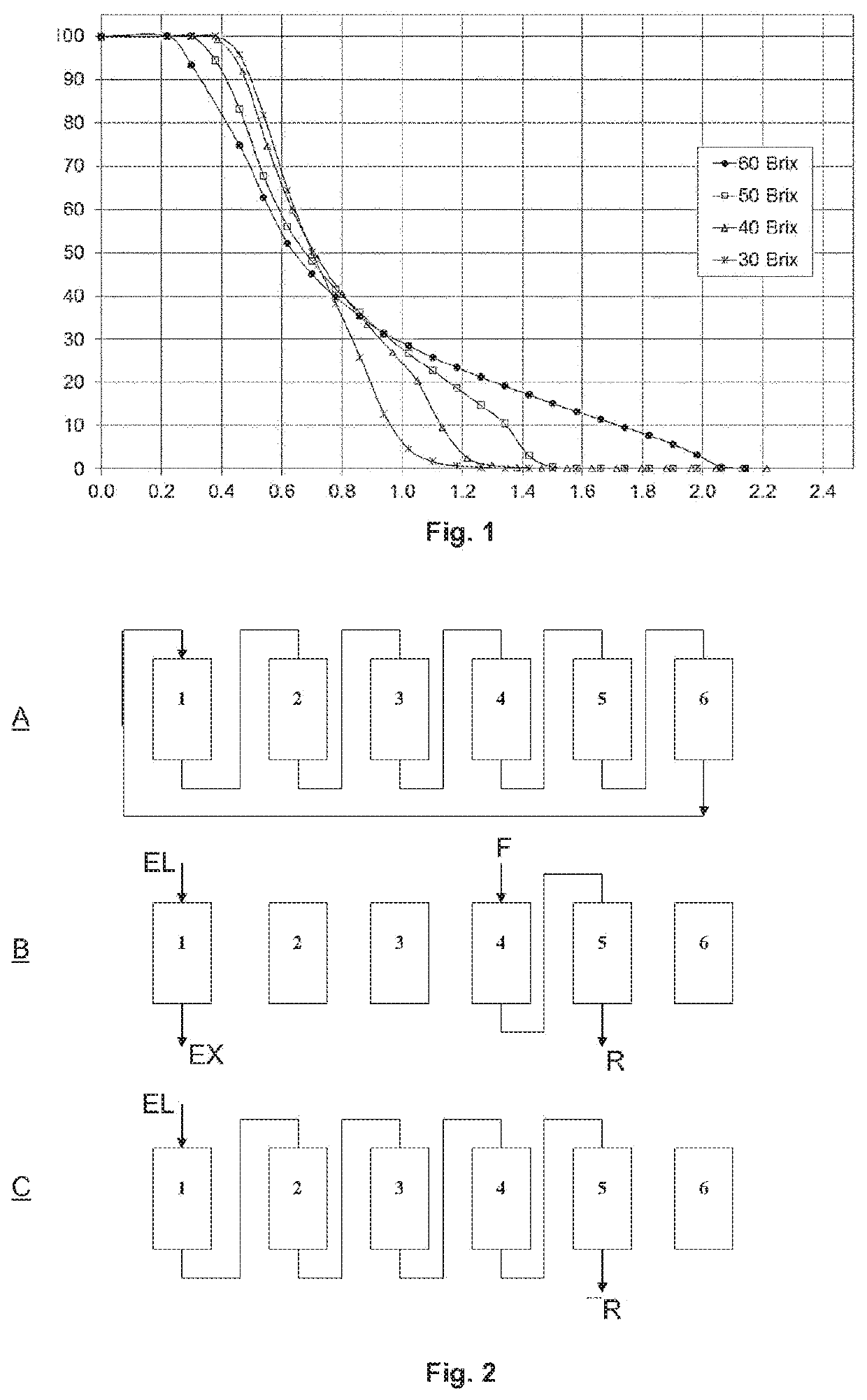Method For Chromatographic Purification Of Viscous Loads
a chromatographic and viscous technology, applied in the direction of glucose production, separation processes, chemistry apparatuses and processes, etc., can solve the problems of large energy consumption and require a relatively heavy installation, and achieve the effects of reducing the volume of eluent consumed (and therefore energy consumption), reducing the volume of stationary phase used, and increasing the volume of feedstock
- Summary
- Abstract
- Description
- Claims
- Application Information
AI Technical Summary
Benefits of technology
Problems solved by technology
Method used
Image
Examples
example 2 (
Invention)
[0220]This example is implemented according to the diagram of FIG. 4 described above (installation with two evaporators, and inlet flow of the chromatographic unit having a dry matter mass concentration of 50%).
[0221]In this example, the volume of water (eluent) used is equal to 0.15 BV and the volume of feedstock to be treated is equal to 0.25 BV. The following table summarizes the characteristics of the compositions passing in different lines of the installation, in the same manner as in Example 1.
Line212223252628293Flow rate807788788358326194326Dry matter31%50%50%50%77%00Fructose 0% 7%42%42%55%——Glucose95%88%53%53%40%——Polysaccharides 5% 5% 5% 5% 5%——
[0222]In this example, the twater / tHFS ratio is equal to 0.77. The VCHR / tHFS ratio is equal to 0.3 m3 / t.
[0223]Compared with Example 1, it appears that despite a drop in the concentration of the product at the inlet of the chromatography (from 60 to 50% of dry matter), while decreasing the total volume of elution water and i...
example 3 (
Invention)
[0224]This example is similar to Example 2, except that the volume of water used is equal to 0.14 BV and that the volume of feedstock to be treated is equal to 0.27 BV. The following table summarizes the characteristics of the compositions passing in different lines of the installation, in the same way as in the preceding examples:
Line212223252628293Flow rate807782782358326178326Dry matter31%50%50%50%77%00Fructose 0% 7%42%42%55%——Glucose95%88%53%53%40%——Polysaccharides 5% 5% 5% 5% 5%——
[0225]In this example, the twater / tHFS ratio is equal to 0.71. The VCHR / tHFS ratio is equal to 0.32 m3 / t. This example demonstrates that if the volume of elution water is further lowered, while also increasing the volume of feedstock to be treated (compared to Example 2), the volume of resin per ton of final product is a little superior but the performance obtained on the volume of water per ton of final product remains very advantageous.
example 4 (
Invention)
[0226]This example is similar to Example 2, except that the volume of water used is equal to 0.14 BV and that the volume of feedstock to be treated is equal to 0.17 BV. In addition, the length of columns is reduced to 1.40 m instead of the 2 m in the previous examples. The following table summarizes the characteristics of the compositions passing in different lines of the installation, in the same way as in the preceding examples:
Line212223252628293Flow rate807700700341326264326Dry matter31%50%50%50%77%00Fructose 0% 3%42%42%55%——Glucose95%91%52%52%40%——Polysaccharides 5% 6% 6% 6% 5%——
[0227]In this example, the twater / tHFS ratio is equal to 0.96. The VCHR / tHFS ratio is equal to 0.27 m3 / t. This example demonstrates that it is possible to work with shorter columns while maintaining good productivity, which makes it possible to obtain good performance in water consumption and particularly optimized with respect to resin requirements. Other settings may be found to lower the wa...
PUM
| Property | Measurement | Unit |
|---|---|---|
| viscosity | aaaaa | aaaaa |
| operating temperature | aaaaa | aaaaa |
| velocity | aaaaa | aaaaa |
Abstract
Description
Claims
Application Information
 Login to View More
Login to View More - R&D
- Intellectual Property
- Life Sciences
- Materials
- Tech Scout
- Unparalleled Data Quality
- Higher Quality Content
- 60% Fewer Hallucinations
Browse by: Latest US Patents, China's latest patents, Technical Efficacy Thesaurus, Application Domain, Technology Topic, Popular Technical Reports.
© 2025 PatSnap. All rights reserved.Legal|Privacy policy|Modern Slavery Act Transparency Statement|Sitemap|About US| Contact US: help@patsnap.com


